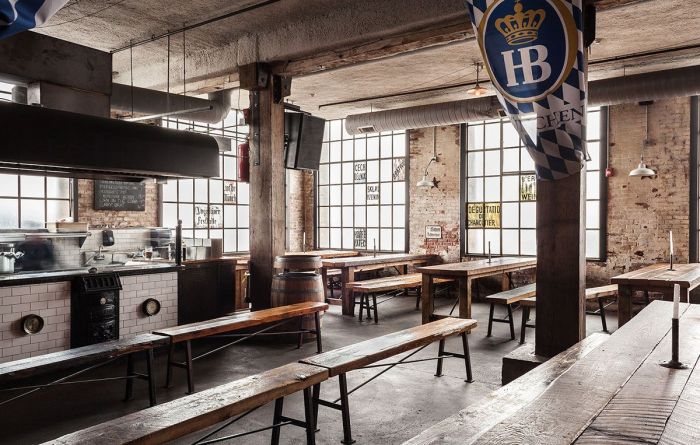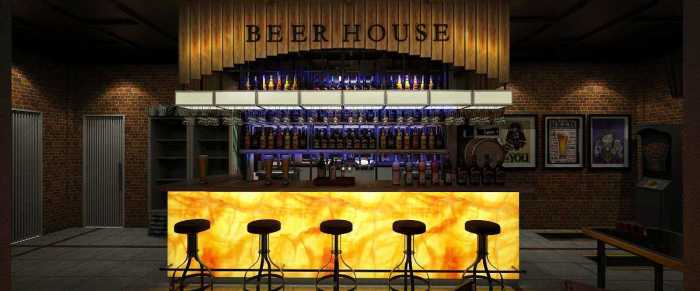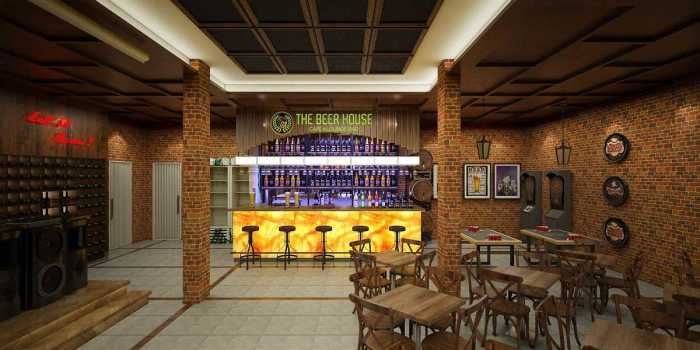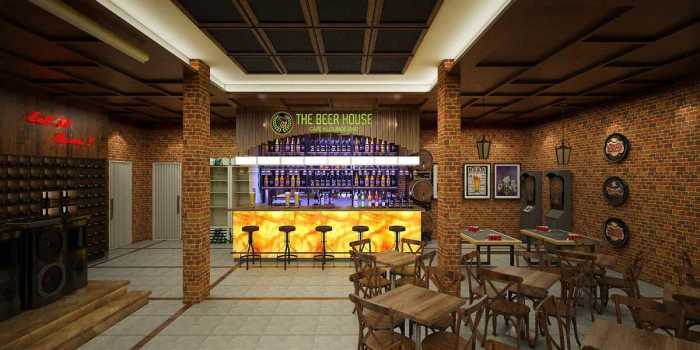Beer house interior design goes beyond just aesthetics; it’s about crafting an experience that draws customers in and keeps them coming back. From the moment they step inside, the atmosphere should be inviting, reflecting the brand’s personality and offering a comfortable space to enjoy a pint.
The key to success lies in a careful balance of design elements, functionality, and ambiance. Lighting, seating, and color schemes all play a crucial role in creating the desired mood, while materials, textures, and patterns contribute to the overall aesthetic.
Trends in Beer House Design: Beer House Interior Design

The world of beer houses is constantly evolving, with design trends reflecting the changing tastes of consumers and the rise of new technologies. From the use of sustainable materials to the integration of digital experiences, modern beer houses are embracing innovative approaches to create welcoming and engaging spaces.
This section explores current trends in beer house interior design, examining the influence of emerging technologies, materials, and design philosophies, and offering insights into future trends shaping the industry.
Influence of Emerging Technologies, Beer house interior design
The integration of technology is transforming the beer house experience. Here are some examples of how technology is influencing design:
- Interactive Displays and Digital Menus:Beer houses are incorporating interactive displays and digital menus to enhance the customer experience. These technologies allow patrons to browse beer selections, learn about brewing processes, and even order food and drinks directly from their tables.
- Smart Lighting and Automation:Smart lighting systems can adjust the ambiance of a beer house throughout the day, creating different moods for different occasions. Automation systems can streamline operations, such as controlling temperature and lighting, and enhancing energy efficiency.
- Virtual Reality Experiences:Some beer houses are experimenting with virtual reality (VR) experiences to offer unique and immersive engagements. VR can transport patrons to breweries, provide virtual tours of production facilities, or even allow them to participate in interactive brewing simulations.
Use of Sustainable Materials
Sustainability is becoming increasingly important in the hospitality industry, and beer houses are embracing eco-friendly design principles.
- Recycled and Upcycled Materials:Many beer houses are incorporating recycled and upcycled materials into their interiors, such as reclaimed wood, repurposed furniture, and recycled glass. This approach reduces waste and promotes a sense of environmental responsibility.
- Local and Sustainable Sourcing:Beer houses are sourcing materials locally whenever possible, reducing transportation emissions and supporting local businesses. This practice aligns with the growing trend of supporting sustainable and ethical practices.
- Energy-Efficient Design:Beer houses are incorporating energy-efficient features into their designs, such as LED lighting, solar panels, and high-performance insulation. These measures contribute to reducing energy consumption and minimizing the environmental footprint of the establishment.
Focus on Community and Experience
Modern beer houses are moving away from the traditional pub model and focusing on creating spaces that foster a sense of community and offer engaging experiences.
A beer house interior design can be a fun and challenging project. You’ll want to create a space that’s inviting and comfortable for patrons, but also reflects the unique character of your establishment. One way to bring your vision to life is by utilizing 3d house interior design software.
This allows you to experiment with different layouts, colors, and textures before committing to any changes. By using 3D design tools, you can ensure that your beer house interior is a hit with customers and staff alike.
- Open and Inviting Layouts:Beer houses are adopting open floor plans with communal seating areas, fostering interaction and a sense of shared experience. This encourages patrons to connect with each other and engage with the staff.
- Event Spaces and Entertainment:Many beer houses are incorporating dedicated event spaces for live music, trivia nights, and other entertainment options. These spaces provide opportunities for patrons to socialize and enjoy a variety of experiences.
- Emphasis on Local Craft Beer:The rise of craft beer has fueled a trend towards supporting local breweries and offering a diverse selection of artisanal brews. This focus on local craft beer enhances the customer experience and fosters a sense of community.
Integration of Design Philosophies
Beer house design is increasingly influenced by various design philosophies, each contributing to the overall aesthetic and experience.
- Industrial Chic:This design philosophy emphasizes exposed brick, metal accents, and vintage industrial elements, creating a raw and edgy atmosphere.
- Rustic Farmhouse:This style incorporates natural wood, stone, and farmhouse-inspired décor, creating a warm and inviting ambiance.
- Minimalist and Modern:Minimalist and modern designs prioritize clean lines, neutral colors, and functional furniture, creating a sophisticated and streamlined aesthetic.
Conclusion

Designing a successful beer house interior requires a careful balance of functionality, aesthetics, and atmosphere. This discussion has explored key aspects of beer house design, highlighting the importance of creating a welcoming and inviting space that caters to both the casual drinker and the beer enthusiast.
A beer house interior design can be a blend of rustic charm and modern comfort, with exposed brick walls and warm lighting. To achieve a truly captivating space, consider incorporating elements of aesthetic interior house design , like carefully curated artwork, vintage furniture, and a touch of greenery.
This balance of industrial and aesthetic elements will create a welcoming atmosphere that’s perfect for enjoying a cold beer with friends.
Key Takeaways
The design elements discussed in this exploration provide a comprehensive framework for creating a compelling beer house experience. By incorporating these elements, designers can ensure that their spaces are not only functional but also visually appealing and conducive to a positive customer experience.
A beer house interior design often embraces a warm and inviting atmosphere, with rustic elements like exposed brick and wood. This can be achieved by incorporating elements from other cultures, such as the intricate patterns and vibrant colors found in arabian house interior design.
These design elements can add a touch of exotic charm and create a unique and memorable experience for patrons.
- Functionality: The layout of the space, the selection of furniture, and the efficient flow of service are essential for a smooth and enjoyable experience.
- Aesthetics: The use of lighting, color palettes, and decorative elements can create a unique and memorable atmosphere that reflects the brand’s identity.
- Atmosphere: The overall ambiance of the space, including music, lighting, and seating arrangements, plays a crucial role in shaping the customer experience.
- Trends: Incorporating contemporary design trends, such as industrial chic, rustic farmhouse, and modern minimalist, can attract a wider audience and enhance the appeal of the space.
Wrap-Up

Ultimately, a successful beer house interior design is about creating a space that resonates with the target audience, fostering a sense of community, and providing a memorable experience. By incorporating elements that enhance the overall experience, such as music, aromas, and unique features, beer houses can become more than just places to grab a drink; they can become destinations.
Query Resolution
What are some common mistakes to avoid in beer house interior design?
Common mistakes include neglecting acoustics, using uncomfortable seating, ignoring accessibility, and failing to create a clear flow of traffic.
How can I incorporate sustainability into my beer house design?
Consider using recycled materials, energy-efficient lighting and appliances, and locally sourced furniture.
What are some tips for choosing the right lighting for a beer house?
Balance ambient lighting with task lighting, consider using dimmable lights for different moods, and incorporate natural light whenever possible.




